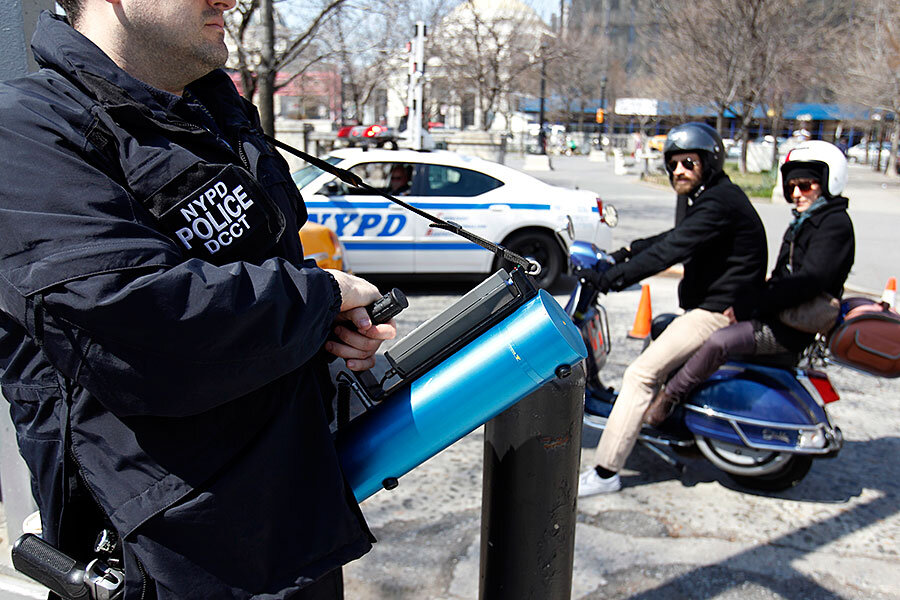Dirty bombs: update on US safeguards
Loading...
What is a dirty bomb?
The Nuclear Regulatory Commission (NRC) defines a dirty bomb as a device that “combines conventional explosives, such as dynamite, with radioactive material.” Its detonation would result in a “regular” explosion, with the added effect of dispersing radioactive material.
But the consequences might not be as dire as some fear. “This wouldn’t be like a nuclear bomb,” says David Albright, the first nongovernmental inspector of Iraq’s nuclear program in 1996, and a frequent testifier on nuclear issues before Congress. “It’s important for people to understand that it can be dangerous, but the risk isn’t what the public often imagines – making a city uninhabitable, causing hundreds or thousands of deaths.”
What are the safeguards surrounding radioactive materials in the United States?
The NRC is responsible for ensuring the safe use of radioactive sources for civilian uses. The group works with other agencies, both domestic and international, to track and control all nuclear material designated for peaceful purposes. “We as a country have spent billions making sure these materials can’t be smuggled in,” but those efforts would be for naught if a “bad actor” could simply acquire them from within, says David Trimble, who heads the department in the Government Accountability Office (GAO) that conducted the recent investigation.
A set of regulations, based upon International Atomic Energy Agency designations, governs the distribution of radioactive sources in the US. Category 1 materials are the most dangerous, and Category 5 the least.
Why did the GAO conduct its investigation?
In 2007, the agency carried out an operation almost identical to the recent effort – with sobering results. It set up fictitious companies and was able to obtain an NRC license for Category 3 materials. And by altering that license, it entered into agreements with multiple suppliers, giving it access to dangerous quantities.
Now, almost a decade later, the GAO aimed to assess what had changed. After the last investigation, for example, mandatory site visits were introduced; previously, the whole process had taken place over the phone.
This time, the GAO team created fake websites to serve as refer-
ences, giving their fake businesses glowing reviews. It set up spaces for the nonexistent companies but left them vacant, doing nothing to make them appear legitimate.
Twice, inspectors refused to grant licenses – one uncovering the fake references, the other demanding that the site be more developed. The third, however, was content with assurances that the site would be further developed, and granted the license. Again, the operatives altered the license and were able to place orders with two suppliers.
What can be done?
“NRC staff are already considering the GAO recommendations,” says Maureen Conley, an NRC spokeswoman. “All of that will then be rolled into a paper and presented to the commission. They will decide how to proceed.”
The commission is led by five politically appointed commissioners.
In 2009, after the GAO’s first covert operation, the commission rejected a proposal to include Category 3 materials in the nascent National Source Tracking System. The argument was that the NSTS was experiencing too many teething troubles to be expanded beyond Categories 1 and 2. As soon as the GAO’s new report was published in July, Jeff Baran, one of the NRC commissioners, stated in a memorandum that it was “time to revisit the question of whether and how to track Category 3 sources.”
“The NRC appears to be taking our work seriously and is already implementing corrective actions,” says Mr. Trimble of the GAO. “Of course we can’t be sure they’ll get them all done, but they’re on the right track.”
Is it a good idea to publicize this kind of information?
Some may question the wisdom of sharing publicly how an undercover investigation obtained materials for a dirty bomb. But Trimble says the only way the shortcomings will be addressed is if they “see the light of day.”
“The point is that these things can be fixed,” he says. “If we had uncovered things that couldn’t be fixed, we would have considered that very sensitively.” There certainly are occasions, he says, when issues are handled “through other channels.”
Mr. Albright, who is also founder and president of the Institute for Science and International Security in Washington, agrees. First, he says, it acts as an alert for people to show “due diligence” in controlling the hazardous materials. Second, it provides an opportunity to put things in perspective, to remind people that while a dirty bomb is dangerous, the imagined horrors tend to exceed reality.








